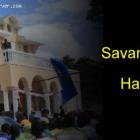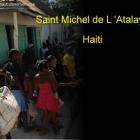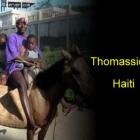ADVERTISEMENT
Deforestation - Haiti Observer Blog
Deforestation, Haiti Observer Blog. Read the following articles about Deforestation
Sean Penn to make Haiti a model of Forestation with "Here come the Trees"
As you may know, there is currently a U.N. climate conference taking place in Paris, which runs through Dec. 11. It is one of the most important events of our time, involving leaders of some of the most powerful nations in the world. The objective of the conference is to achieve a legally binding and universal agreement on climate, from all the nations of the world.
Of the many countries at risk from the effects of climate change, small island such as Haiti is considered to be among the most vulnerable to sea level rise due to its high population densities, fragile ecosystems, overstressed water resources and others.
Haiti and Dominican Republic to jointly protect the environment
After the end of second level talk between Haiti and Dominican Republic in Jimani, the capital and the second largest city of the Independencia Province in the Dominican Republic, the two neighboring nations have agreed to protect the surrounding environment of Hispaniola Island which they jointly occupy. Though they share an island, they have remained worlds apart so far. This has played a direct role in adverse climate changes and its consequences in the area. The environment ministers from the two countries have agreed upon the urgent need to save the island's natural resources and environment. They will work under joint programs to manage cross-border natural resources and improve undivided watersheds. The two countries will deploy funds, manpower and work with the local communities in a collaborative way. Some international organizations will be engaged to find solution for environmental deterioration.
Pine forest (Foret des Pins) in Danger of Extinction
Haiti University Faculty of Law students are on a mission to save the Pine Forest of Haiti. A lush environment of stately trees and riotous wild flowers, it is in danger of becoming extinct through abandonment and misuse. The forest is a victim of deforestation, in which an ingrained habit, born of need, motivates rural residents to hew the wood to produce charcoal, so they may heat their homes and cook meals.
A non-government agency (NGA), USAID PAPH, has joined the students to produce a documentary film, which depicts them planting saplings as part of a rite to highlight their concerns about losing Pine Forest. During the program at the end of a three-day conference, attended by members of Parliament, they performed poetry readings and sang their country's national songs.
Limbe, A Historic Haitian City
Limbé is located in Haiti's Nord Department. In the Limbe Arrondissement, it is a municipality inhabited by 32200 inhabitants as per 2003 census. After Cap Haitien it is the second most important city. Bas-Limbe and Limbe are the two communes which include other seven rural sections. It is located to the north of Haiti's capital, Port-au-Prince at a distance of 220 km. L'Acul-du-Nord, Bas-Limbé, Cap-Haïtien, Port-Margot and Plaisance are the neighboring cities and towns to access from Limbe.
From where does Limbe derives its strength
Limbe city derives its strength and a base of diverse agriculture from the Limbe River. Near the sea in Bas-Limber, rice is produced and in the city's surrounding areas, mango, coffee, banana and fruits of other kinds are produced.
Foret des Pins or The Pine Forest, a Haitian patrimony to safeguard
The long and wizened history of Foret des Pins, an expanse of forest consisting of coniferous tropical and sub-tropical plants, involves widespread deforestation for varying reasons over different points in time. Once, in the first years of the twentieth century, the Pine Forest was about 32,000 hectares, today, only 6,000 hectares remain.
Foret des Pins, which straddles the border of Haiti and neighboring Dominican Republic, has been ravaged through the years by natural disasters such as floods, landslides and earthquakes. It's also suffered under the hands of the government and the population. Widespread illegal logging led to a decree in 1937 declaring the forest as a 'special' site, and a law in 1962 against the clearing of sloping land. These steps did little to stop the cutting down of trees during the Duvalier years as well as the damage caused by farmers who clear the land to create space for their produce.
Brother Franklin Armand - Pandiassou, Haiti
With their belief that the Gospel cannot exist in tandem with misery CPFSI, and its founder Brother Franklin Armand, began a program that has turned life around for the inhabitants of one village in the Haitian city of Hinche.
With the entire country facing economic difficulties, exacerbated by the vicious cycle of agricultural deforestation, residents of Pandiassou, a small settlement in Haiti's Central Plateau, have benefited from the efforts of the missionary and their campaign to turn around the ability of the peasantry to sustain themselves in today's socio-economic climate.
Started over 25 years before, the Congregation of Little Brothers and Sisters of the Incarnate (CPFSI) first began by aiding the peasantry to feed itself. Once the immediate needs were met they set about making this abundance self-sustainable and stamping out the crippling dependency on food aid. What they established was a Konbit-like system of community farming that maximized the efficiency of the community's production. Unlike a traditional Konbit, the peasants are instrumental in the planning stages, which manifests in a more successfully cooperative undertaking.
Solutions for Deforestation Blocked by Government Incompetence
The island of Haiti was once blanketed by forests. Foreign countries, though, raped the land over many decades. During the era after America was founded, forests had decreased 5%, and during the French occupation, they declined another 45%. By 1956, only 20% remained. By the end of the 1980s, the percentage dropped to 2% left of forested terrain.
Zile Ayiti te yon fwa rekouvèr pa forè. Peyi etranje yo, fe kadejak sou peyi a pandan plizie deseni. Pandan epòk apre Amerik te fonde, forè te diminye 5%, ak pandan okipasyon Franse, yo te diminye yon lòt 45%. Le ou rive nan 1956, sèlman 20% rete. Rive nan fen 1980 yo, pousantaj la tonbe nan 2% kite nan tèren forè.
Bill Clinton and Richard Branson to Launch Haiti Forest Initiative
The Clinton Foundation, Virgin Unite and Yunus Social Business have teamed up to re-forest Haiti. The three entity's, backed by three of the world's most influential men, former US President Bill Clinton, billionaire Richard Branson and microfinance creator and peace prize winner Mohammed Yunus, seek not just to replant what has been lost over the past 500 years, but to provide employment, timber, and food while creating a model for programs that can bring positive change to the country. The initiative, called Haiti Forest, has the promise of ten thousand hectares of land from the Agriculture and Environment Ministries in the Artibonite and northern regions of Haiti, and is said to be a Social Business, promoting social benefit over privatized profiteering.
The Environment in Grand-Gosier
Efforts are being exerted to improve the environment of the town of Grand-Gosier in Belle-Anse Arrondissement. This small town in the Sud Est department has experienced environmental degradation in the past. Rampant illegal logging is never good for the environment and Grand-Gosier's land was not spared from it. Due to too much logging of wood, the town's environment suffered and was greatly damaged. It also caused the extensive deforestation in the municipality. Because of this, non-government organizations became concerned about the town's environment. Therefore, they came up with plans and programs to restore the environment, which is very important. The organizations made efforts to reforest the affected areas.
Livelihood In the town of Carice, Haiti
Thousands of people live in Carice, a remote town located in the Vallieres arrondissement in Haiti. According to statistics, the town has about 12,000 residents. Carice is a rural area without as many sources of livelihood as in cities and industrialized towns. This is why people rely on agriculture for their main livelihood. Farmers in the town mostly harvest mangoes, bananas and coffee, which are considered the main and most popular products in the area.
Though agriculture is the main source of livelihood in the town, deforestation is still common. As a matter of fact, deforestation affected the soil quality in the town. Despite this, however, the production of crops remains and continues to support people's livelihood.
Our objective is to share with you news and information about Haiti and the people of Haiti. Traditions, habits and the way we were or grew are alive in this site. We highly recommend that you Subscribe to our Newsletter and also share with us some of the things that are memorable and made us unique people.

 The Town of Savanette, Haiti
The Town of Savanette, Haiti  Haitian Thanksgiving
Haitian Thanksgiving  Saint Michel de L 'Atalaye
Saint Michel de L 'Atalaye  Haitians are a Proud People
Haitians are a Proud People  Thomassique, Haiti
Thomassique, Haiti